Notes: Watton station had two platforms. They were fully staggered, the down (northbound: Swaffham direction) platform being north-west of the southbound, and linked by a boarded foot-crossing that spanned the running lines. There was no footbridge or subway. The station building, signal box and offices were on the northbound platform which was nearest to Norwich Road. There was a shelter on the southbound, Thetford direction, platform. The platform lines were not signalled for two-way traffic. A water crane was sited at the north end of the down platform and a well was sunk to provide a water supply. On one occasion the water system that supplied the crane developed a leak that flooded the station and prevented trains collecting any water. Consequently a telegraph was sent from Watton to Thetford to ensure the next train had enough water to get to Swaffham which read: NO WATER WATTON. FLOODED OUT.
 Trains arriving from Swaffham crossed Norwich Road on the level on a single line. In the station the line doubled immediately after the crossing. There were sidings on both east and west sides of the running lines: all were reached by shunting from the south. The sidings were controlled by a second signal box, also located on the south-west side of the line. The main goods shed adjoined Norwich Road to the east of the crossing and lay at the end of a platform dominated by a one-ton loading crane. Two sidings led to the goods shed and ran along the rear of the southbound passenger platform. A coal and general merchandise yard and extensive cattle pens were located to the south of the station buildings on the west side of the through lines. Trains arriving from Swaffham crossed Norwich Road on the level on a single line. In the station the line doubled immediately after the crossing. There were sidings on both east and west sides of the running lines: all were reached by shunting from the south. The sidings were controlled by a second signal box, also located on the south-west side of the line. The main goods shed adjoined Norwich Road to the east of the crossing and lay at the end of a platform dominated by a one-ton loading crane. Two sidings led to the goods shed and ran along the rear of the southbound passenger platform. A coal and general merchandise yard and extensive cattle pens were located to the south of the station buildings on the west side of the through lines.
To the south of the station on the down side three sheds were built by the Thetford & Watton Railway to provide accommodation for the locomotives and carriages that worked the line. These comprised two single road sheds and a two road shed which would have been for the carriages. The engine shed was closed c1875 when the line was extended to Swaffham. The buildings were leased to corn, coal, coke and seed merchants Tyrrell & Byford in 1909 with an access road running behind the main station buildings. There was a weighbridge at the entrance to the yard. A private siding served the granary and according to the Railway Clearing House Handbook of Stations this was still in use in 1957 and the granary continued trading until 1964. The Thetford and Watton Railway also built a single road shed at Thetford; it opened 28. 1.1869 and closed c1890.
Click here for a picture.
The station was originally called Watton but the Norfolk suffix was added 1 July 1923. This is usually done to avoid confusion with another station of the same name but there was no other Watton station.
The 1952 25in OS Map shows two additional sidings to the south-east of the station, added since the previous edition of the map, compiled in 1906. They lay close to an access road to an extensive war-time air-base (RAF Watton) which opened in 1937. They were constructed to accommodate large amounts of munitions traffic going to the airfield and were built for the US Army Air Force who took over the airfield in 1943. Their site is now occupied by a new housing development and no trace of railway infrastructure remains.
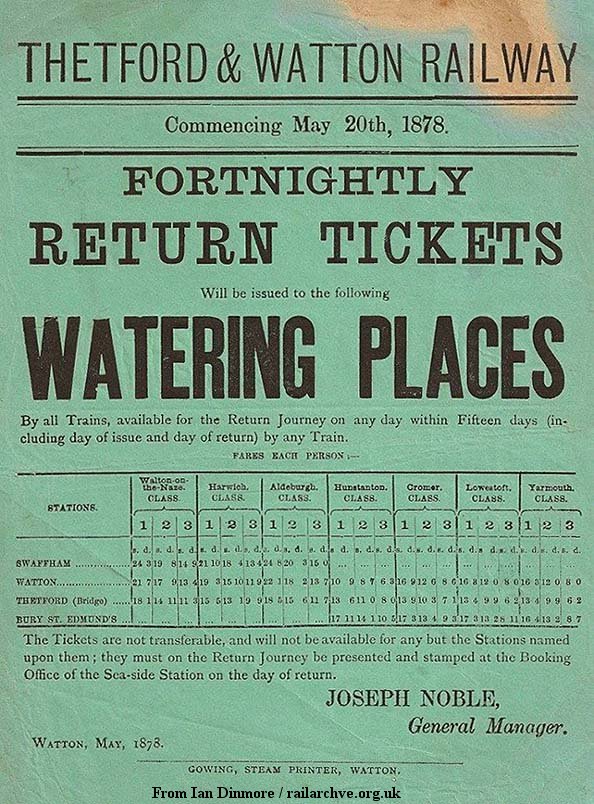
For some years in the middle of the twentieth century the station was adorned by complicated railway-themed topiary hedges, cut and maintained by a Mr Fagg. The station offices were located on the northbound platform. They were built of brick with slate roofing. The two-storey main building’s high pitched roof lay at ninety degrees to the platform. Ancillary rooms, ground floor only, had their roof parallel to the platform face. The main building had a substantial and ornate brick chimneystack at the centre of the roof ridge. Access from the road was through doorways located under a small portico supported by two cast-iron posts. On the platform side the building roof, supported here by one iron column, formed a covered shelter for waiting passengers. The large goods shed was similarly constructed of brick and slate.
 In 1955 the station platforms were gas-lit. The lamp-posts were not adorned by British Railways totem nameplates. William White's History, Gazetteer, and Directory of Norfolk 1883 gives us an insight into some of the businesses grouped around the station and, of course, their reliance upon it for their trade. As well as Tyrrell & Byford there were two ‘corn, coal and cake merchants’. They were R Coller & Son and Thomas Shepherd Howlett; Howlett had their own private siding. Another coal merchant was listed as Chas Knott whilst Robert French Springall, an English and foreign timber merchant who ran a sawmill in King’s Lynn, had a depot at Watton station. The ‘Victualler’ at the nearby Railway Hotel was Richard Wright. Ducks, butter and eggs were the main goods despatched from the station. The Town Guide of 1909 records that some 7.5 tons of ducks per week left via Watton goods yard. In 1955 the station platforms were gas-lit. The lamp-posts were not adorned by British Railways totem nameplates. William White's History, Gazetteer, and Directory of Norfolk 1883 gives us an insight into some of the businesses grouped around the station and, of course, their reliance upon it for their trade. As well as Tyrrell & Byford there were two ‘corn, coal and cake merchants’. They were R Coller & Son and Thomas Shepherd Howlett; Howlett had their own private siding. Another coal merchant was listed as Chas Knott whilst Robert French Springall, an English and foreign timber merchant who ran a sawmill in King’s Lynn, had a depot at Watton station. The ‘Victualler’ at the nearby Railway Hotel was Richard Wright. Ducks, butter and eggs were the main goods despatched from the station. The Town Guide of 1909 records that some 7.5 tons of ducks per week left via Watton goods yard.
A Brief History of the Watton and Swaffham Railway - also known as the Bury and Thetford (Swaffham Branch) Railway
 On 16 July 1866 the Thetford and Watton Railway was incorporated to construct a new railway that would leave the Norwich & Brandon Railway line at Roudham Junction, four and a half miles east of Thetford. It had an authorised capital outlay of £80,000. On 7 July 1869, the company obtained an additional Act that allowed its trains running powers on Great Eastern tracks from Roudham Junction to Thetford and the company to form a junction with the Bury St. Edmunds and Thetford Railway at Thetford. That came to fruition on 15 November 1876. On 16 July 1866 the Thetford and Watton Railway was incorporated to construct a new railway that would leave the Norwich & Brandon Railway line at Roudham Junction, four and a half miles east of Thetford. It had an authorised capital outlay of £80,000. On 7 July 1869, the company obtained an additional Act that allowed its trains running powers on Great Eastern tracks from Roudham Junction to Thetford and the company to form a junction with the Bury St. Edmunds and Thetford Railway at Thetford. That came to fruition on 15 November 1876.
North of Watton a nominally independent company, the Watton and Swaffham Railway, was incorporated on 12 July 1869. It would construct a line to reach a west-facing junction with the former Lynn & Dereham Railway, now part of the Great Eastern, close to Swaffham. The line would be worked by the Thetford and Watton company.

 At Roudham the junction faced west towards Thetford. The railway’s nine-mile route from the main line at Roudham Junction across an agricultural and partly wooded landscape was easy terrain, requiring no significant earthworks or gradients, and the railway was opened through to Watton on 18 October 1869. It was a further six years before completion of the nine and a half-mile extension northwards to Swaffham; it is said that the extension cost £72,000 to build. Its construction was delayed and complicated due to difficult land at Neaton, just north of Watton. Here a deep depression had to be filled and compacted and an embankment formed to carry the railway. Earth was extracted from a pit beside the route. Part of the extraction site was flooded and became known locally as Loch Neaton, allegedly after the Scots navvies who built the railway. The name is still used today. At Roudham the junction faced west towards Thetford. The railway’s nine-mile route from the main line at Roudham Junction across an agricultural and partly wooded landscape was easy terrain, requiring no significant earthworks or gradients, and the railway was opened through to Watton on 18 October 1869. It was a further six years before completion of the nine and a half-mile extension northwards to Swaffham; it is said that the extension cost £72,000 to build. Its construction was delayed and complicated due to difficult land at Neaton, just north of Watton. Here a deep depression had to be filled and compacted and an embankment formed to carry the railway. Earth was extracted from a pit beside the route. Part of the extraction site was flooded and became known locally as Loch Neaton, allegedly after the Scots navvies who built the railway. The name is still used today.
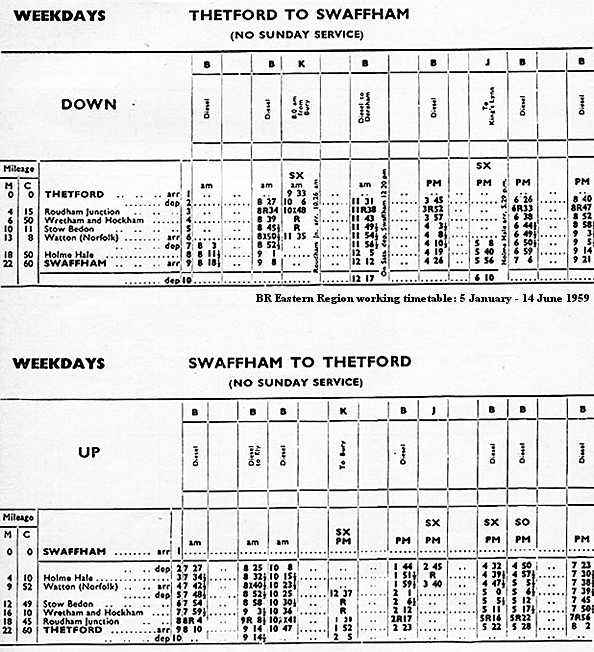
Goods services to Swaffham began on 20 September 1875 but it was not until nearly two months later that the supervising authorities were satisfied that the new embankments at Neaton were safe for passenger traffic to commence; it did so on 15 November.
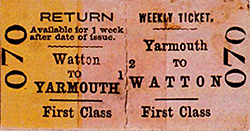 Manning Wardle of Leeds supplied the company’s first locomotives after an offer from Robert Fairlie to test his ‘Fairlie Steam Carriage’ was rejected. The Leeds engines were 0-6-0 tanks with three-foot driving wheels. They were joined by a second-hand rebuilt 3ft 6in gauge locomotive. The engines were housed in a shed at Watton. In 1876 two larger Sharpe, Stewart & Co 0-4-2 tender engines joined the fleet, presumably because of the motive power needs of the new Swaffham extension. Manning Wardle of Leeds supplied the company’s first locomotives after an offer from Robert Fairlie to test his ‘Fairlie Steam Carriage’ was rejected. The Leeds engines were 0-6-0 tanks with three-foot driving wheels. They were joined by a second-hand rebuilt 3ft 6in gauge locomotive. The engines were housed in a shed at Watton. In 1876 two larger Sharpe, Stewart & Co 0-4-2 tender engines joined the fleet, presumably because of the motive power needs of the new Swaffham extension.
Travelling south from Swaffham there were stations at Holme Hale, Watton, Stow Bedon, Wretham & Hockham and Roudham Junction. Although well provided with sidings for goods traffic the junction had no road access, being simply a transfer platform for branch passengers using the Norwich & Brandon Railway’s trains to complete their journey.
On 21 July 1879 agreement was reached to lease the line to the Great Eastern Railway for 999 years, commencing on 1 March 1880. In 1897 it was fully absorbed into the Great Eastern Railway and became part of the London & North Eastern Railway at grouping of the nation’s railways on 1 January 1923.
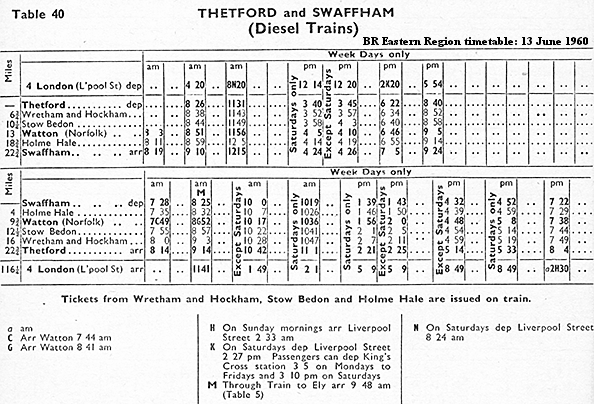
Although not a large town, Watton has a long-established market having received its Charter in 1204 allowing a market to be held on Wednesdays. The coming of the railway invigorated business in the town and two large monthly cattle markets brought livestock traffic to the railway. Like many of East Anglia’s railways it was agriculture that generated much of the goods traffic. From Watton went poultry, butter, milk and eggs, principally to Cambridge and London markets. Coal and other produce not locally available arrived by train.
 As regards tickets issued for travel, Mr T C F Vollacott wrote a short history of the two railways. He asserted that he did not know whether the Watton and Swaffham company had ever issued its own style of ticket: all that he found bear the name of the working company. Several distinct ticket types were issued: all were standard ‘Edmondson’ size. 1st Class singles were white, 2nd rose, 3rd green and ‘parliamentary’ buff coloured. 3rd class returns were green and buff. Early tickets had serial number and date on the face, right and left sides respectively: later ones had the serial number twice on the face and the date on the back. As regards tickets issued for travel, Mr T C F Vollacott wrote a short history of the two railways. He asserted that he did not know whether the Watton and Swaffham company had ever issued its own style of ticket: all that he found bear the name of the working company. Several distinct ticket types were issued: all were standard ‘Edmondson’ size. 1st Class singles were white, 2nd rose, 3rd green and ‘parliamentary’ buff coloured. 3rd class returns were green and buff. Early tickets had serial number and date on the face, right and left sides respectively: later ones had the serial number twice on the face and the date on the back.
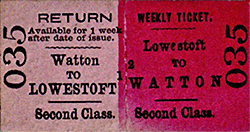 Today, typically of many agricultural areas crossed by closed railways, some of the former trackbed has been ploughed and is indistinguishable from surrounding fields. However, for some distance north of Watton, the line can be seen as a wooded interruption to extensive fields of arable crops. In the parish of Saham Toney some length of embankment remains in view and, close by, substantial brick-built abutments of an overbridge survive on Long Road at Woodbottom Farm. A little further north a brick overbridge is intact crossing Hale Road. Immediately south of Watton little remains of the line in Thompson Parish except at Griston where the railway crossed a minor road. Here can still be seen the crossing-keeper’s hut and, beside it, a gatepost and the remnants of the personnel gate that was part of the level crossing. ‘The Gate House’, much rebuilt and modernised, still stands beside the crossing. Passing through Thetford Forest between Stow Bedon and Hockham Heath the trackbed is a Permitted Public Path before once more being obliterated by agricultural activity towards the site of Roudham Junction. Today, typically of many agricultural areas crossed by closed railways, some of the former trackbed has been ploughed and is indistinguishable from surrounding fields. However, for some distance north of Watton, the line can be seen as a wooded interruption to extensive fields of arable crops. In the parish of Saham Toney some length of embankment remains in view and, close by, substantial brick-built abutments of an overbridge survive on Long Road at Woodbottom Farm. A little further north a brick overbridge is intact crossing Hale Road. Immediately south of Watton little remains of the line in Thompson Parish except at Griston where the railway crossed a minor road. Here can still be seen the crossing-keeper’s hut and, beside it, a gatepost and the remnants of the personnel gate that was part of the level crossing. ‘The Gate House’, much rebuilt and modernised, still stands beside the crossing. Passing through Thetford Forest between Stow Bedon and Hockham Heath the trackbed is a Permitted Public Path before once more being obliterated by agricultural activity towards the site of Roudham Junction.
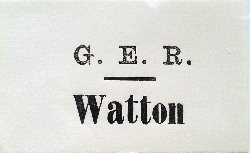 Throughout its life there was little change in the number and frequency of passenger trains on the branch. The 1906 timetable shows five southbound weekday (up) through trains and four down. There was no Sunday service. Additionally, at 8.30 am, a non-stop train left Thetford and terminated at Watton. On Wednesday only market-goers bound for Watton were catered for by a 1.20 pm departure from Swaffham: it set out on its twenty-minute return journey at 3.15 pm. Throughout its life there was little change in the number and frequency of passenger trains on the branch. The 1906 timetable shows five southbound weekday (up) through trains and four down. There was no Sunday service. Additionally, at 8.30 am, a non-stop train left Thetford and terminated at Watton. On Wednesday only market-goers bound for Watton were catered for by a 1.20 pm departure from Swaffham: it set out on its twenty-minute return journey at 3.15 pm.
Steam-hauled passenger services ceased in 1955 when newly arrived diesel multiple units began work out of Dereham, where the steam engine shed closed at the same time. The 1953 steam-worked timetable shows six through trains with no extra services to or from Watton. Sunday saw two trains, both late in the day, the first activity being at 4.32 pm from Swaffham. Indeed, on weekdays, a traveller might reach Swaffham only as late as 9.44 pm, whilst on Sunday evening it was midnight exactly when the second train reached the town!

By 1960 no steam locomotives plied the line on passenger trains and the Sunday service had disappeared. Five down trains ran throughout, supplemented by an 8.03 am Watton departure to Swaffham (the first up train made a long stop at Watton so may have detached a unit there to form the extra train). One, the 8.25 am from Swaffham, ran through to Ely: there was no corresponding down service.
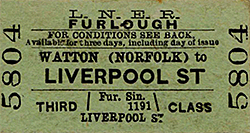 Tickets for travel from intermediate stations, except at Watton, were issued by the guard. This had happened since Great Eastern Railway days, providing evidence of low numbers of passengers using the line’s smaller stations. Tickets for travel from intermediate stations, except at Watton, were issued by the guard. This had happened since Great Eastern Railway days, providing evidence of low numbers of passengers using the line’s smaller stations.
Steam locomotives worked out of Swaffham engine shed, a sub-shed of Norwich Thorpe (shed code 32A in BR days). Photographs from the 1950s show passenger work in the hands of D16 4-4-0s and goods trains hauled by various former Great Eastern 0-6-0 types. Latterly Class 03 diesel shunters were to be found working goods turns on the branch.
The final timetable in force before closure of the line to passengers shows five through trains in each direction. In addition there was an 8.00 am Watton to Swaffham service. An 8.20 am Thetford to Watton train returned from the market town at 8.49 am after a five minute stop. There was no Sunday service.
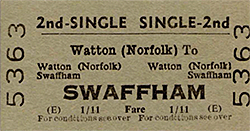 The British Railways Board published Dr Richard Beeching’s report The Reshaping of Britain’s Railways on 27 March 1963. By 20 September of that year the Eastern Region had published proposals to close the Thetford to Watton Branch, allowing two months for consultation and objections. With what may seem like undue haste Ernest Marples, Minister of Transport, received a report on 9 January 1965 and gave his consent to closure on 27 February. The 'Crab and Winkle line', as it was known locally, closed on 15 June 1964. The last passenger service, the 9.21 pm from Thetford to Swaffham, ran on 12th June 1964 and was formed of a two-car diesel multiple unit with driver David Grant of Dereham in charge, carrying, it was reported locally, seventy passengers. Roudham Junction to Watton closed completely. The line north of Watton closed finally on 19 April 1965. The last train carried in coal and took away a sugar-beet harvest. Rails were removed soon after. The British Railways Board published Dr Richard Beeching’s report The Reshaping of Britain’s Railways on 27 March 1963. By 20 September of that year the Eastern Region had published proposals to close the Thetford to Watton Branch, allowing two months for consultation and objections. With what may seem like undue haste Ernest Marples, Minister of Transport, received a report on 9 January 1965 and gave his consent to closure on 27 February. The 'Crab and Winkle line', as it was known locally, closed on 15 June 1964. The last passenger service, the 9.21 pm from Thetford to Swaffham, ran on 12th June 1964 and was formed of a two-car diesel multiple unit with driver David Grant of Dereham in charge, carrying, it was reported locally, seventy passengers. Roudham Junction to Watton closed completely. The line north of Watton closed finally on 19 April 1965. The last train carried in coal and took away a sugar-beet harvest. Rails were removed soon after.
Route map drawn by Alan Young. Tickets from Michael Stewart. BR timetables from Alan Young, working timetable from Julian Horn
Particular thanks to Julian Horn for information, ephemera and a large number of photographs. Julian is a local historian and publisher of the Wayland News and Pictures of Watton Facebook Group.
To see the other
stations on the Watton & Swaffham Railway click on the station name: Roudham Junction, Wretham & Hockham, Stow Bedon, Holme Hale & Swaffham |

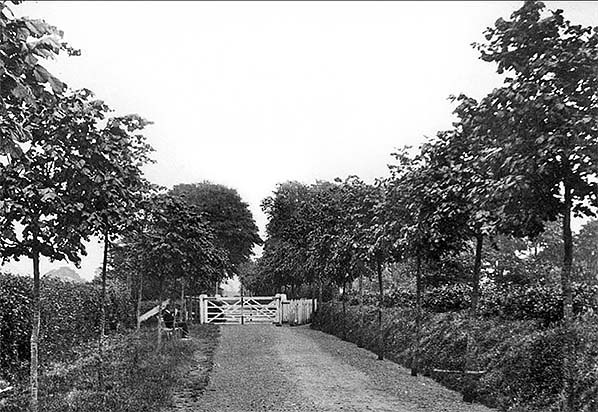

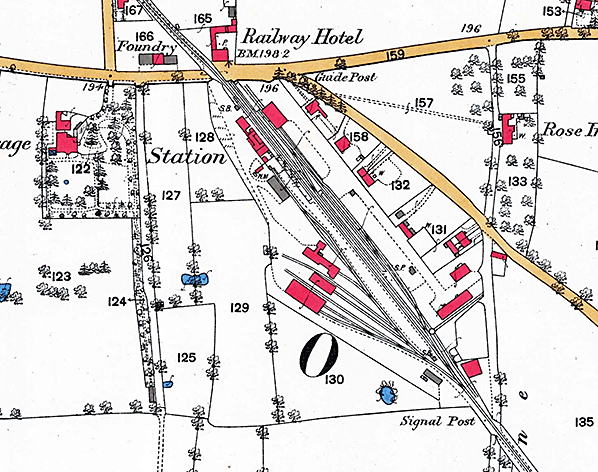
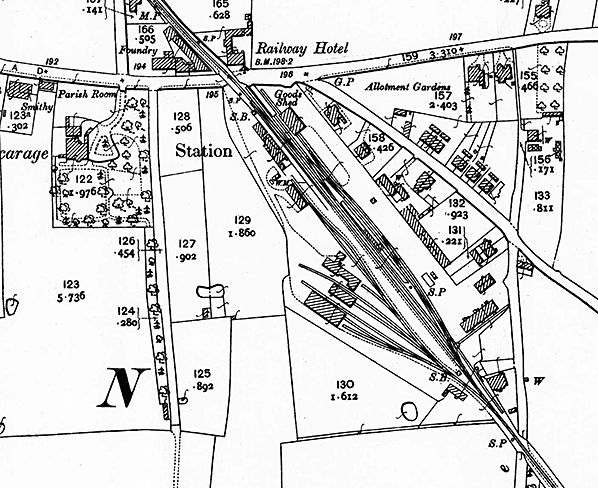
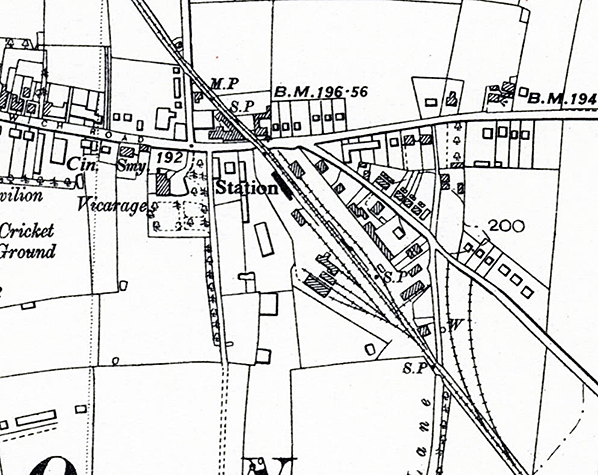
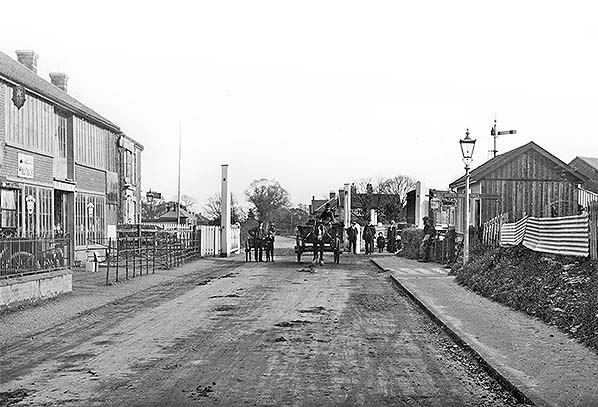
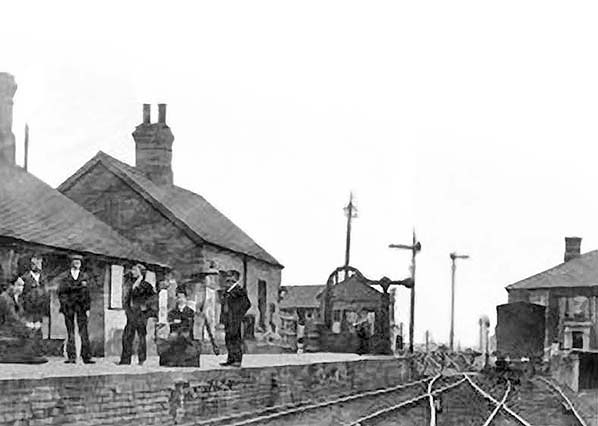
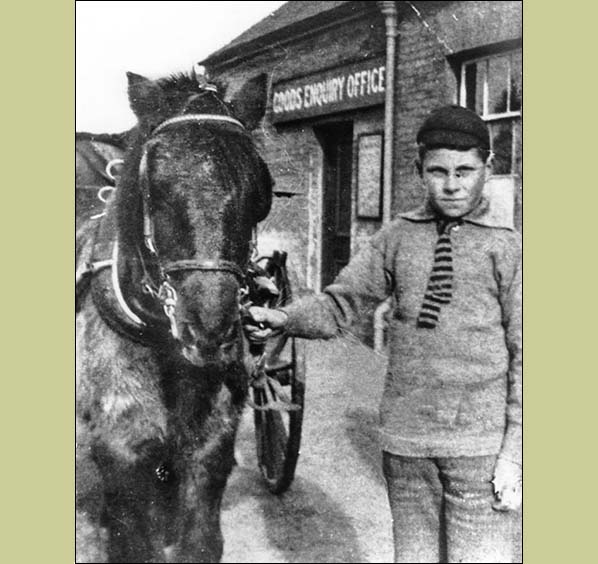
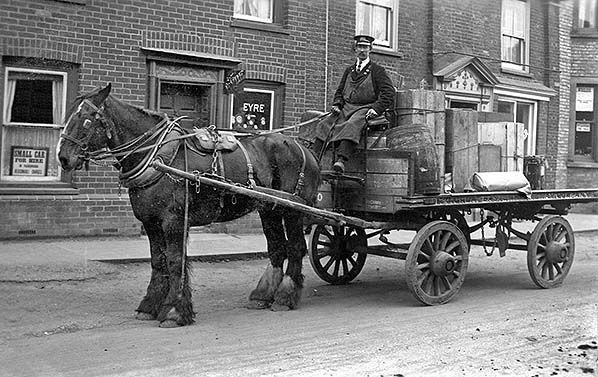
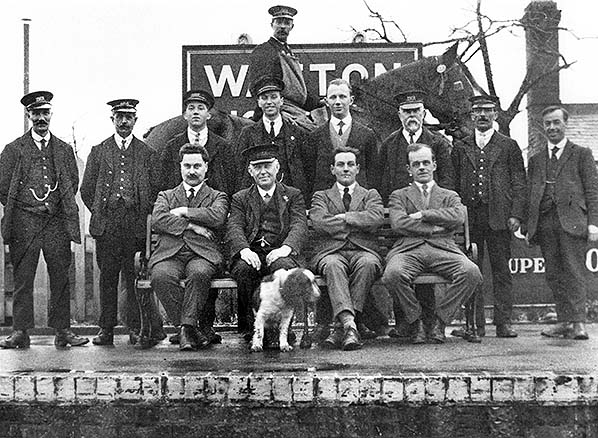
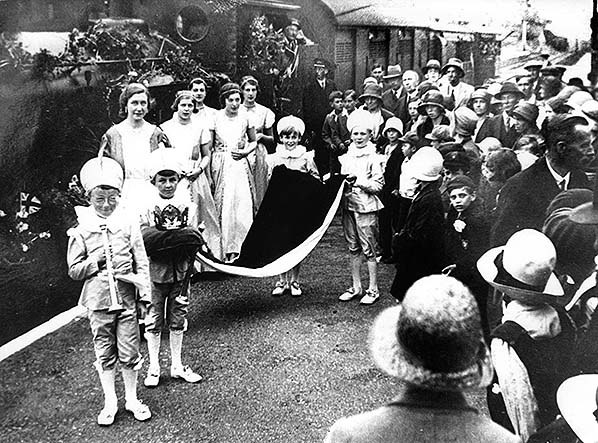 Meeting the 1929 Watton Carnival Queen off the train from Stow Bedon. It was the tradition that the Carnival Queen joined a train at Stow Bedon. The train was decorated and proceeded to Watton where it was met by the mayor. Station master Leech is seen at the back of the crowd. The locomotive appears to be an F3 2-4-2 Tank; 50 were built by the Great Eastern Railway between 1893 and 1902.
Meeting the 1929 Watton Carnival Queen off the train from Stow Bedon. It was the tradition that the Carnival Queen joined a train at Stow Bedon. The train was decorated and proceeded to Watton where it was met by the mayor. Station master Leech is seen at the back of the crowd. The locomotive appears to be an F3 2-4-2 Tank; 50 were built by the Great Eastern Railway between 1893 and 1902.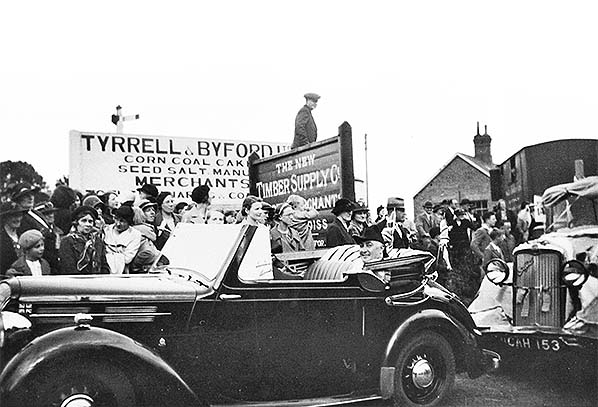 The Watton Carnival procession leaves Watton goods yard in 1938. Signs for two of the goods yard merchants are clearly seen, Tyrell & Byford corn and seed merchant and the Timber Supply Company (later to become Bardwells Timber) are seen.
The Watton Carnival procession leaves Watton goods yard in 1938. Signs for two of the goods yard merchants are clearly seen, Tyrell & Byford corn and seed merchant and the Timber Supply Company (later to become Bardwells Timber) are seen. Trains arriving from Swaffham crossed Norwich Road on the level on a single line. In the station the line doubled immediately after the crossing. There were sidings on both east and west sides of the running lines: all were reached by shunting from the south. The sidings were controlled by a second signal box, also located on the south-west side of the line. The main goods shed adjoined Norwich Road to the east of the crossing and lay at the end of a platform dominated by a one-ton loading crane. Two sidings led to the goods shed and ran along the rear of the southbound passenger platform. A coal and general merchandise yard and extensive cattle pens were located to the south of the station buildings on the west side of the through lines.
Trains arriving from Swaffham crossed Norwich Road on the level on a single line. In the station the line doubled immediately after the crossing. There were sidings on both east and west sides of the running lines: all were reached by shunting from the south. The sidings were controlled by a second signal box, also located on the south-west side of the line. The main goods shed adjoined Norwich Road to the east of the crossing and lay at the end of a platform dominated by a one-ton loading crane. Two sidings led to the goods shed and ran along the rear of the southbound passenger platform. A coal and general merchandise yard and extensive cattle pens were located to the south of the station buildings on the west side of the through lines. 
 In 1955 the station platforms were gas-lit. The lamp-posts were not adorned by British Railways totem nameplates. William White's History, Gazetteer, and Directory of Norfolk 1883 gives us an insight into some of the businesses grouped around the station and, of course, their reliance upon it for their trade. As well as Tyrrell & Byford there were two ‘corn, coal and cake merchants’. They were R Coller & Son and Thomas Shepherd Howlett; Howlett had their own private siding. Another coal merchant was listed as Chas Knott whilst Robert French Springall, an English and foreign timber merchant who ran a sawmill in King’s Lynn, had a depot at Watton station. The ‘Victualler’ at the nearby Railway Hotel was Richard Wright. Ducks, butter and eggs were the main goods despatched from the station. The Town Guide of 1909 records that some 7.5 tons of ducks per week left via Watton goods yard.
In 1955 the station platforms were gas-lit. The lamp-posts were not adorned by British Railways totem nameplates. William White's History, Gazetteer, and Directory of Norfolk 1883 gives us an insight into some of the businesses grouped around the station and, of course, their reliance upon it for their trade. As well as Tyrrell & Byford there were two ‘corn, coal and cake merchants’. They were R Coller & Son and Thomas Shepherd Howlett; Howlett had their own private siding. Another coal merchant was listed as Chas Knott whilst Robert French Springall, an English and foreign timber merchant who ran a sawmill in King’s Lynn, had a depot at Watton station. The ‘Victualler’ at the nearby Railway Hotel was Richard Wright. Ducks, butter and eggs were the main goods despatched from the station. The Town Guide of 1909 records that some 7.5 tons of ducks per week left via Watton goods yard.  On 16 July 1866 the Thetford and Watton Railway was incorporated to construct a new railway that would leave the Norwich & Brandon Railway line at Roudham Junction, four and a half miles east of Thetford. It had an authorised capital outlay of £80,000. On 7 July 1869, the company obtained an additional Act that allowed its trains running powers on Great Eastern tracks from Roudham Junction to Thetford and the company to form a junction with the Bury St. Edmunds and Thetford Railway at Thetford. That came to fruition on 15 November 1876.
On 16 July 1866 the Thetford and Watton Railway was incorporated to construct a new railway that would leave the Norwich & Brandon Railway line at Roudham Junction, four and a half miles east of Thetford. It had an authorised capital outlay of £80,000. On 7 July 1869, the company obtained an additional Act that allowed its trains running powers on Great Eastern tracks from Roudham Junction to Thetford and the company to form a junction with the Bury St. Edmunds and Thetford Railway at Thetford. That came to fruition on 15 November 1876. 
 At Roudham the junction faced west towards Thetford. The railway’s nine-mile route from the main line at Roudham Junction across an agricultural and partly wooded landscape was easy terrain, requiring no significant earthworks or gradients, and the railway was opened through to Watton on 18 October 1869. It was a further six years before completion of the nine and a half-mile extension northwards to Swaffham; it is said that the extension cost £72,000 to build. Its construction was delayed and complicated due to difficult land at Neaton, just north of Watton. Here a deep depression had to be filled and compacted and an embankment formed to carry the railway. Earth was extracted from a pit beside the route. Part of the extraction site was flooded and became known locally as
At Roudham the junction faced west towards Thetford. The railway’s nine-mile route from the main line at Roudham Junction across an agricultural and partly wooded landscape was easy terrain, requiring no significant earthworks or gradients, and the railway was opened through to Watton on 18 October 1869. It was a further six years before completion of the nine and a half-mile extension northwards to Swaffham; it is said that the extension cost £72,000 to build. Its construction was delayed and complicated due to difficult land at Neaton, just north of Watton. Here a deep depression had to be filled and compacted and an embankment formed to carry the railway. Earth was extracted from a pit beside the route. Part of the extraction site was flooded and became known locally as 
 Manning Wardle of Leeds supplied the company’s first locomotives after an offer from Robert Fairlie to test his ‘Fairlie Steam Carriage’ was rejected. The Leeds engines were 0-6-0 tanks with three-foot driving wheels. They were joined by a second-hand rebuilt 3ft 6in gauge locomotive. The engines were housed in a shed at Watton. In 1876 two larger Sharpe, Stewart & Co 0-4-2 tender engines joined the fleet, presumably because of the motive power needs of the new Swaffham extension.
Manning Wardle of Leeds supplied the company’s first locomotives after an offer from Robert Fairlie to test his ‘Fairlie Steam Carriage’ was rejected. The Leeds engines were 0-6-0 tanks with three-foot driving wheels. They were joined by a second-hand rebuilt 3ft 6in gauge locomotive. The engines were housed in a shed at Watton. In 1876 two larger Sharpe, Stewart & Co 0-4-2 tender engines joined the fleet, presumably because of the motive power needs of the new Swaffham extension.
 As regards tickets issued for travel, Mr T C F Vollacott wrote a short history of the two railways. He asserted that he did not know whether the Watton and Swaffham company had ever issued its own style of ticket: all that he found bear the name of the working company. Several distinct ticket types were issued: all were standard ‘Edmondson’ size. 1st Class singles were white, 2nd rose, 3rd green and ‘parliamentary’ buff coloured. 3rd class returns were green and buff. Early tickets had serial number and date on the face, right and left sides respectively: later ones had the serial number twice on the face and the date on the back.
As regards tickets issued for travel, Mr T C F Vollacott wrote a short history of the two railways. He asserted that he did not know whether the Watton and Swaffham company had ever issued its own style of ticket: all that he found bear the name of the working company. Several distinct ticket types were issued: all were standard ‘Edmondson’ size. 1st Class singles were white, 2nd rose, 3rd green and ‘parliamentary’ buff coloured. 3rd class returns were green and buff. Early tickets had serial number and date on the face, right and left sides respectively: later ones had the serial number twice on the face and the date on the back.  Today, typically of many agricultural areas crossed by closed railways, some of the former trackbed has been ploughed and is indistinguishable from surrounding fields. However, for some distance north of Watton, the line can be seen as a wooded interruption to extensive fields of arable crops. In the parish of Saham Toney some length of embankment remains in view and, close by, substantial brick-built abutments of an overbridge survive on Long Road at Woodbottom Farm. A little further north a brick overbridge is intact crossing Hale Road. Immediately south of Watton little remains of the line in Thompson Parish except at Griston where the railway crossed a minor road. Here can still be seen the crossing-keeper’s hut and, beside it, a gatepost and the remnants of the personnel gate that was part of the level crossing. ‘The Gate House’, much rebuilt and modernised, still stands beside the crossing. Passing through Thetford Forest between Stow Bedon and Hockham Heath the trackbed is a Permitted Public Path before once more being obliterated by agricultural activity towards the site of Roudham Junction.
Today, typically of many agricultural areas crossed by closed railways, some of the former trackbed has been ploughed and is indistinguishable from surrounding fields. However, for some distance north of Watton, the line can be seen as a wooded interruption to extensive fields of arable crops. In the parish of Saham Toney some length of embankment remains in view and, close by, substantial brick-built abutments of an overbridge survive on Long Road at Woodbottom Farm. A little further north a brick overbridge is intact crossing Hale Road. Immediately south of Watton little remains of the line in Thompson Parish except at Griston where the railway crossed a minor road. Here can still be seen the crossing-keeper’s hut and, beside it, a gatepost and the remnants of the personnel gate that was part of the level crossing. ‘The Gate House’, much rebuilt and modernised, still stands beside the crossing. Passing through Thetford Forest between Stow Bedon and Hockham Heath the trackbed is a Permitted Public Path before once more being obliterated by agricultural activity towards the site of Roudham Junction. Throughout its life there was little change in the number and frequency of passenger trains on the branch. The 1906 timetable shows five southbound weekday (up) through trains and four down. There was no Sunday service. Additionally, at 8.30 am, a non-stop train left Thetford and terminated at Watton. On Wednesday only market-goers bound for Watton were catered for by a 1.20 pm departure from Swaffham: it set out on its twenty-minute return journey at 3.15 pm.
Throughout its life there was little change in the number and frequency of passenger trains on the branch. The 1906 timetable shows five southbound weekday (up) through trains and four down. There was no Sunday service. Additionally, at 8.30 am, a non-stop train left Thetford and terminated at Watton. On Wednesday only market-goers bound for Watton were catered for by a 1.20 pm departure from Swaffham: it set out on its twenty-minute return journey at 3.15 pm. 
 Tickets for travel from intermediate stations, except at Watton, were issued by the guard. This had happened since Great Eastern Railway days, providing evidence of low numbers of passengers using the line’s smaller stations.
Tickets for travel from intermediate stations, except at Watton, were issued by the guard. This had happened since Great Eastern Railway days, providing evidence of low numbers of passengers using the line’s smaller stations. The British Railways Board published Dr Richard Beeching’s report The Reshaping of Britain’s Railways on 27 March 1963. By 20 September of that year the Eastern Region had published proposals to close the Thetford to Watton Branch, allowing two months for consultation and objections. With what may seem like undue haste Ernest Marples, Minister of Transport, received a report on 9 January 1965 and gave his consent to closure on 27 February. The '
The British Railways Board published Dr Richard Beeching’s report The Reshaping of Britain’s Railways on 27 March 1963. By 20 September of that year the Eastern Region had published proposals to close the Thetford to Watton Branch, allowing two months for consultation and objections. With what may seem like undue haste Ernest Marples, Minister of Transport, received a report on 9 January 1965 and gave his consent to closure on 27 February. The '


 Home Page
Home Page